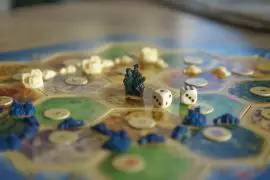Board games have been a popular form of entertainment for generations. From classic games like Monopoly and Risk to newer games like Settlers of Catan and Ticket to Ride, there is a board game for everyone. Board games can be played with family and friends, providing a fun way to spend time together while engaging in a bit of friendly competition.
However, not all board games are created equal, and some games have been met with negative reviews and criticism. In this article, we will take a closer look at some of the worst board games in history. We will examine the gameplay of these games, the flaws and criticisms they have received, and their lasting impact on the world of board games. By doing so, we hope to provide a better understanding of what makes a good board game and why some games fail to meet those standards.
Monopoly
Contents

Monopoly is a classic board game that has been around for over 80 years. The game is designed for two to eight players. The objective is to become the wealthiest player by buying and developing properties while collecting rent from other players who land on those properties.
The gameplay of Monopoly involves rolling dice to move around the board, buying properties, and paying rent when other players land on those properties. The game also includes “Chance” and “Community Chest” cards that can either help or hinder players’ progress.
Despite its popularity, Monopoly has also received significant criticism over the years. One of the most significant criticisms of Monopoly is that the game can be too long and drawn out, often lasting for hours. The game’s competitive nature can also lead to arguments and hurt feelings among players. Additionally, some have criticized the game for promoting cutthroat capitalism and reinforcing social and economic inequality.
Despite these criticisms, Monopoly has remained popular and has even evolved to include new versions that reflect modern cultural trends and themes. The enduring appeal of Monopoly can be attributed to its ability to bring people together for a shared experience, as well as its nostalgia factor for those who grew up playing the game.
Risk
Risk is a classic board game that was first introduced in the 1950s. The game is designed for two to six players, and the objective is to conquer the world by occupying territories and eliminating other players’ armies.
The gameplay of Risk involves players taking turns to place armies on territories, attacking other territories to gain control, and defending against attacks from other players. The game also includes strategic elements such as alliances and troop movements.
However, Risk has also faced criticism over the years. One of the main criticisms of the game is that it can be overly complex and time-consuming, making it difficult for casual players to enjoy. Additionally, some have criticized the game’s emphasis on military conquest and its potential to reinforce harmful stereotypes and historical inaccuracies.
Despite these criticisms, Risk has remained popular among board game enthusiasts. The game’s strategic depth and emphasis on player interaction make it a compelling choice for those who enjoy a challenge. Additionally, Risk has undergone various revisions and adaptations over the years, including digital versions and tie-ins with popular franchises like Game of Thrones, which have helped to keep the game relevant and appealing to new audiences.
The Game of Life
The Game of Life is a board game that has been around since the 1860s. The game is designed for two to six players, and the objective is to navigate through various life stages, making decisions along the way that will affect the player’s career, family, and finances.
The gameplay of The Game of Life involves spinning a wheel to determine the player’s moves, making choices about career and family, and managing finances through various life events such as buying a home or having children. The game also includes various spaces and cards that can either help or hinder the player’s progress.
However, The Game of Life has faced criticism over the years for its lack of complexity and its reinforcement of traditional gender roles. Critics have argued that the game’s simplistic view of life does not accurately reflect the challenges and complexities of real life. Additionally, the game has been criticized for its narrow and stereotypical depiction of gender roles, which can be harmful to young players.
Despite these criticisms, The Game of Life has remained a popular board game and significantly impacted popular culture. The game has been adapted into various forms, including digital versions and themed versions based on popular franchises such as SpongeBob SquarePants and The Avengers. Additionally, The Game of Life has become a cultural touchstone, referenced in TV shows and movies, and has become a part of the broader cultural conversation surrounding nostalgia and childhood memories.

Sorry!
Sorry! is a board game that was first introduced in the 1930s. The game is designed for two to four players, and the objective is to move all four of your colored pawns from start to home while also sending other players’ pawns back to the start.
The gameplay of Sorry! It involves players drawing cards that allow them to move their pawns, either forwards or backward and also allows them to send other players’ pawns back to start. The game also includes special cards that allow players to make extra moves or skip ahead spaces.
Despite its popularity, Sorry! has also faced criticism over the years. One of the main criticisms of the game is that it can be overly reliant on luck and lacks strategic depth. Additionally, some have criticized the game for its potential to reinforce negative behaviors, such as gloating over other players’ misfortunes.
Despite these criticisms, Sorry! has evolved over the years to include various versions and adaptations, including digital versions and themed versions based on popular franchises like Disney and Star Wars. The game’s simplicity and accessibility have made it a popular choice for families and children, and its cultural impact can be seen in its continued popularity and enduring status as a classic board game.
Chutes and Ladders
Chutes and Ladders is a board game that was first introduced in the 1940s. The game is designed for two to four players, and the objective is to be the first player to reach the end of the board by climbing ladders and avoiding chutes that can send you back to the beginning.
The gameplay of Chutes and Ladders involves players rolling a die to determine their moves and progressing along the board by climbing ladders and avoiding chutes. The game also includes various spaces that can either help or hinder the player’s progress, such as spaces that allow extra rolls or spaces that require the player to move back.
While Chutes and Ladders is a popular choice for young children, it has also faced criticism over the years. One of the main criticisms of the game is that it can be overly simplistic and lacks strategic depth. Additionally, some have criticized the game for its potential to reinforce harmful stereotypes and behaviors, such as the idea that success is purely based on luck rather than effort or skill.
Despite these criticisms, Chutes and Ladders have had historical significance as one of the earliest board games specifically designed for young children. The game has evolved over the years to include various adaptations, including digital versions and themed versions based on popular children’s franchises such as Paw Patrol and Dora the Explorer. The game’s accessibility and simplicity have made it a popular choice for families with young children, and its historical significance can be seen in its enduring status as a classic children’s board game.
Other Worst Board Games
While Monopoly, Risk, Sorry!, and Chutes and Ladders are some of the most well-known board games, there are several other games that have also faced criticism and negative reviews over the years. Here are a few examples:
The Game of Thrones Board Game – This game has faced criticism for its complex rules and lengthy playing time, which can make it difficult to learn and play for casual players. Additionally, some players have criticized the game for its reliance on player alliances and politics, which can lead to frustrating gameplay experiences.
Candy Land – This game has faced criticism for its lack of player agency and reliance on luck. Some critics have argued that the game’s simplistic gameplay and lack of strategic depth make it uninteresting for older children and adults.
Clue – While Clue is a classic murder mystery game, it has faced criticism over the years for its reliance on luck and lack of replayability. Some players have also criticized the game for its stereotypical character portrayals and lack of diversity.
Axis and Allies – This game has faced criticism for its lengthy playing time and complex rules, which can make it difficult to learn and play for casual players. Additionally, some players have criticized the game for its portrayal of World War II, which can be seen as insensitive or inappropriate.
While these games have faced criticism and negative reviews, it’s worth noting that they still have their fans and continue to be played by many. Like any form of entertainment, board games are subjective; what one person may see as a flaw, another may see as a feature.

So, What are the worst board games?
Board games have been a popular form of entertainment for decades, offering players a chance to engage in strategic gameplay and social interaction with friends and family. However, even the most beloved board games have faced criticism over the years. Some games face criticism for their lack of strategic depth, reliance on luck, or potential to reinforce harmful stereotypes.
Throughout this article, we have explored some of the worst board games in terms of their flaws and criticisms. We have looked at Monopoly, Risk, Sorry!, Chutes and Ladders, and several other games, analyzing their gameplay, criticisms, and impact on popular culture.
Despite the criticisms, it’s worth noting that board games have evolved over the years in response to player feedback and criticism. For example, newer versions of Monopoly have attempted to address some of the game’s flaws by introducing new rules and mechanics. Similarly, other board games have adapted to players’ changing needs and preferences over time.
Ultimately, the value of board games as a form of entertainment lies in their ability to bring people together, promote social interaction, and offer a chance for strategic gameplay. While not every board game may be a perfect fit for every player, the wide range of options available means that there is something for everyone.
In conclusion, while the worst board games may have flaws and criticisms, they still offer valuable entertainment for those who enjoy them. As board games continue to evolve and adapt to changing player preferences, it will be interesting to see what new games will emerge and how they will shape the future of this timeless form of entertainment.
Want to why we use a clock in chess? Read it here.





